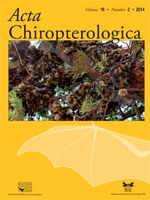The molecular identification of prey in faeces is an efficient non-invasive technique to study diet which requires both a satisfactory method of DNA extraction and the design of specific primers to selectively amplify prey's DNA. In this study we evaluated and compared the efficiency of two total DNA extraction methods and five primer pairs for the molecular identification of birds from scats, in particular from the giant noctule bat (Nyctalus lasiopterus). A modified DNA stool Mini Kit of Qiagen was tested against a modified silica method with a guanidinium thiocianate (GuSCN) applied after freezing and pulverizing the samples. We also checked two published vertebrate- and bird-generalist primer pairs and three bird-specific primer pairs designed by us (two pairs targeting the cytochrome b and one the cytochrome oxidase subunit I genes) that amplified shorter DNA fragments. The results show that pulverizing the scat remains before extraction was a very important step, presumably facilitating access to the well preserved DNA located inside the rachis of the feathers. The combination of our bird-specific designed primers showed a higher amplification rate than the generalist primers and allowed successful bird identification from the feathers excreted by the giant noctule bat in all the scat samples analyzed, independent of the preservation method used (dried and frozen). These methodological improvements will allow not only the study of the avian diet composition of the enigmatic giant noctule, but the extension of this methodology to other bird predators such as raptors.
How to translate text using browser tools
1 December 2014
A Molecular Approach to the Study of Avian DNA in Bat Faeces
David Pastor-Beviá,
Carlos Ibáñez,
Juan Luís García-Mudarra,
Javier Juste
ACCESS THE FULL ARTICLE

Acta Chiropterologica
Vol. 16 • No. 2
December 2014
Vol. 16 • No. 2
December 2014
amplification success
bird DNA
conservation
DNA extraction
faeces
giant noctule bat
primer design




